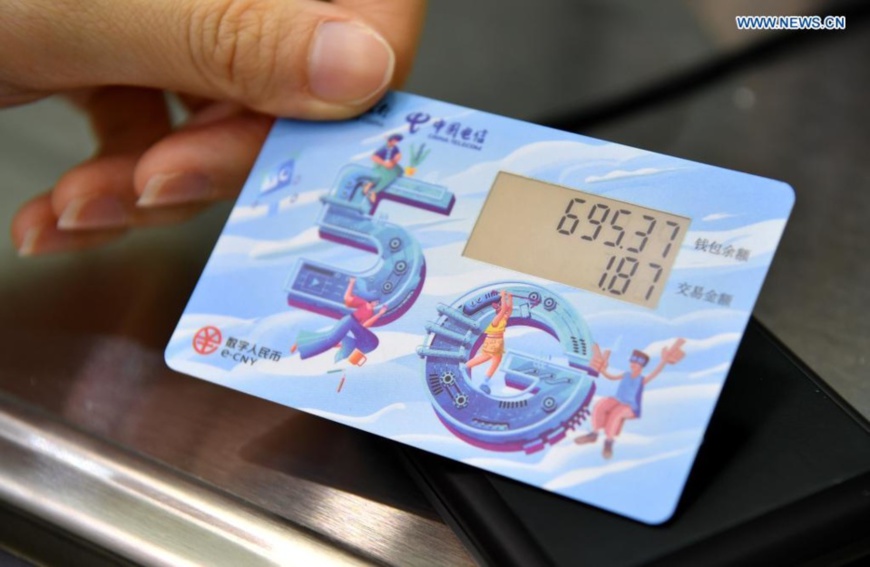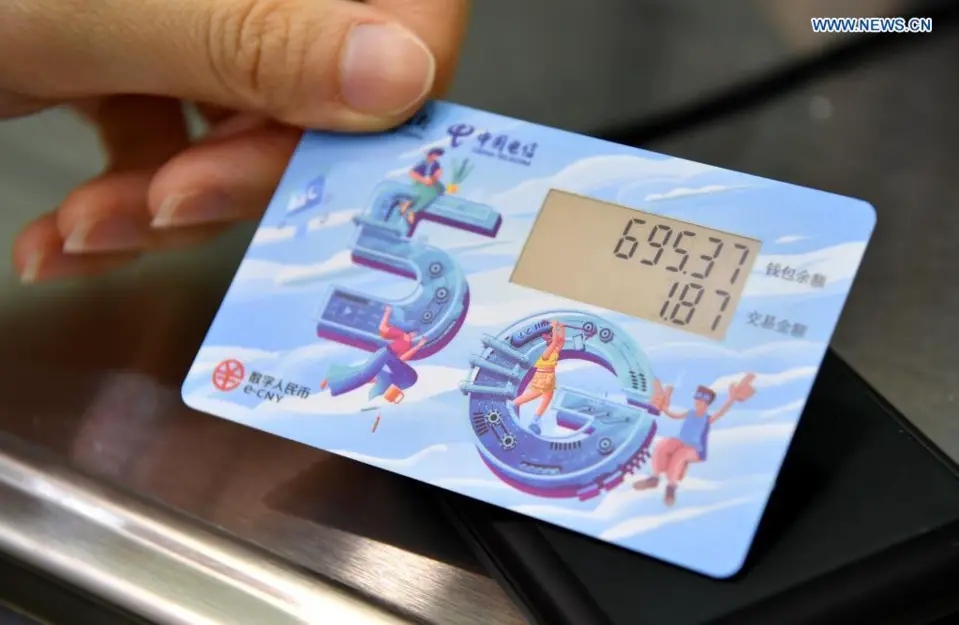By Guan Kejiang, People's Daily

Photo taken on May 8, 2021 shows a digital Chinese yuan (e-CNY) payment card used at the first China International Consumer Products Expo in Haikou, capital of south China's Hainan Province. Several banks have offered experience zones for payment with e-CNY at the Expo. (Xinhua/Guo Cheng)
Electronic payments in the retail sector of Saudi Arabia reached 57 percent of total transactions conducted in the country in 2021, up from 36 percent two years ago, according to a recent survey by the country's central bank.
In 2021, over 5.5 billion payments were executed through point of sale (PoS) in Saudi Arabia, which represented 243 percent growth from 2019. Among them, 95 percent were conducted through contactless payment methods.
Digital payment is developing rapidly in Gulf countries. According to a survey by Mastercard, 88 percent of residents in the United Arab Emirates (UAE) used one or more emerging payment methods. Mobile payment was the most popular one, followed by BNPL (Buy Now, Pay Later). Most respondents said they used digital payment because it was safe and convenient.
McKinsey & Company said the transaction volume of digital payment in the UAE had kept increasing nine percent or more each year between 2014 and 2019, higher than the average in Europe which stood at four percent to five percent. According to the management consulting firm, the UAE is expected to become completely cashless by 2030.
Since January this year, Oman has made digital payment mandatory at shopping centers, restaurants and supermarkets. Digital payment transactions in Kuwait surged 46 percent year on year in 2021.
Bahrain is the first among all Gulf countries to launch digital payment services. According to statistics released by the country's central bank, digital payment of the country grew 13.1 percent year on year in July this year.
On Aug. 30 this year, Qatar's central bank issued the first license for digital payments to two fintech firms, allowing them to offer relevant services.
Analysts believe that the prospering e-commerce sector is an important force driving the rapid development of digital payment in Gulf countries. These countries are latecomers in e-commerce, but boast high penetration of internet and high per capita income. They enjoy huge development potential in this regard. Amid COVID-19, Gulf countries saw further development of e-commerce, and the market is expected to hit $50 billion in 2025, from $24 billion in 2020.
Gulf countries generally adopt policies that encourage digital payment. J.K. Khalil, Mastercard's Cluster General Manager of MENA (Middle East and North Africa) East, said Gulf countries' passion for digital payment is inspiring.
Saudi Arabia's "Saudi Vision 2030" plan takes digital transformation as an important goal, aiming to digitalize 70 percent of the country's total transactions.
The UAE established a "Cashless Dubai Working Group" that aims to shift all payment transactions in Dubai to secure and easy-to-use cashless platforms across sectors.
Gulf countries have carried out active international cooperation on digital payment. The common digital currency project “Aber” jointly launched by Saudi Arabia and the UAE, the Buna multi-currency payment platform established by the Arab Monetary Fund for its member countries, as well as the joint regional payments platform AFAQ that links real-time gross settlement systems for each Gulf Cooperation Council country, all support cross-border digital payment.
China has played an important role in accelerating the development of digital payment in Gulf countries, and the two sides are constantly enhancing their digital cooperation. Chinese tech firms are actively joining the digital development of Gulf countries to build a digital Silk Road.
Zhong Hong, deputy dean of the Academy of Bank of China, told People's Daily that digital payment creates a safe, effective and low-cost transaction environment, makes financial services accessible to more people and enhances people's wellbeing in Gulf countries.
She said digital payment, employing big data, artificial intelligence and other technologies, will contribute to the digital transformation of Gulf countries and create new impetus for their economic development.
In 2021, over 5.5 billion payments were executed through point of sale (PoS) in Saudi Arabia, which represented 243 percent growth from 2019. Among them, 95 percent were conducted through contactless payment methods.
Digital payment is developing rapidly in Gulf countries. According to a survey by Mastercard, 88 percent of residents in the United Arab Emirates (UAE) used one or more emerging payment methods. Mobile payment was the most popular one, followed by BNPL (Buy Now, Pay Later). Most respondents said they used digital payment because it was safe and convenient.
McKinsey & Company said the transaction volume of digital payment in the UAE had kept increasing nine percent or more each year between 2014 and 2019, higher than the average in Europe which stood at four percent to five percent. According to the management consulting firm, the UAE is expected to become completely cashless by 2030.
Since January this year, Oman has made digital payment mandatory at shopping centers, restaurants and supermarkets. Digital payment transactions in Kuwait surged 46 percent year on year in 2021.
Bahrain is the first among all Gulf countries to launch digital payment services. According to statistics released by the country's central bank, digital payment of the country grew 13.1 percent year on year in July this year.
On Aug. 30 this year, Qatar's central bank issued the first license for digital payments to two fintech firms, allowing them to offer relevant services.
Analysts believe that the prospering e-commerce sector is an important force driving the rapid development of digital payment in Gulf countries. These countries are latecomers in e-commerce, but boast high penetration of internet and high per capita income. They enjoy huge development potential in this regard. Amid COVID-19, Gulf countries saw further development of e-commerce, and the market is expected to hit $50 billion in 2025, from $24 billion in 2020.
Gulf countries generally adopt policies that encourage digital payment. J.K. Khalil, Mastercard's Cluster General Manager of MENA (Middle East and North Africa) East, said Gulf countries' passion for digital payment is inspiring.
Saudi Arabia's "Saudi Vision 2030" plan takes digital transformation as an important goal, aiming to digitalize 70 percent of the country's total transactions.
The UAE established a "Cashless Dubai Working Group" that aims to shift all payment transactions in Dubai to secure and easy-to-use cashless platforms across sectors.
Gulf countries have carried out active international cooperation on digital payment. The common digital currency project “Aber” jointly launched by Saudi Arabia and the UAE, the Buna multi-currency payment platform established by the Arab Monetary Fund for its member countries, as well as the joint regional payments platform AFAQ that links real-time gross settlement systems for each Gulf Cooperation Council country, all support cross-border digital payment.
China has played an important role in accelerating the development of digital payment in Gulf countries, and the two sides are constantly enhancing their digital cooperation. Chinese tech firms are actively joining the digital development of Gulf countries to build a digital Silk Road.
Zhong Hong, deputy dean of the Academy of Bank of China, told People's Daily that digital payment creates a safe, effective and low-cost transaction environment, makes financial services accessible to more people and enhances people's wellbeing in Gulf countries.
She said digital payment, employing big data, artificial intelligence and other technologies, will contribute to the digital transformation of Gulf countries and create new impetus for their economic development.
 Menu
Menu
 Gulf countries see rapid development in digital payment
Gulf countries see rapid development in digital payment
















